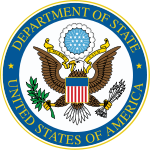United States Secretary of State
| United States Secretary of State |
|
|---|---|
 Official seal United States Department of State |
|
| Inaugural holder | Thomas Jefferson |
| Formation | April 6, 1789 |
| Succession | Fourth |
| Website | www.state.gov |

The United States Secretary of State is the head of the United States Department of State, concerned with foreign affairs. The Secretary is a member of the Cabinet and the highest-ranking cabinet secretary both in line of succession and order of precedence. The current Secretary of State is Hillary Rodham Clinton, the 67th person, and third woman to hold the post.
Contents |
Functions
The position grew out of the short-lived Secretary of Foreign Affairs; most of the functions of the Secretary of State still revolve around foreign matters. The Secretary is commonly the chief diplomat of the United States, and advises the President on matters relating to foreign issues.
The specific duties of the Secretary of State include:[1]
- Supervises the United States Foreign Service and the United States Department of State.
- Advises the President on matters relating to U.S. foreign policy, including the appointment of diplomatic representatives to other nations, and on the acceptance or dismissal of representatives from other nations.
- Participates in high-level negotiations with other countries, either bilaterally or as part of an international conference or organization, or appoints representatives to do so. This includes the negotiation of international treaties and other agreements.
- Providing information and services to U.S. citizens living or traveling abroad, including providing credentials in the form of passports and visas.
- Supervises the United States immigration policy abroad.
- Communicates issues relating the United States foreign policy to Congress and to U.S. citizens.
The original duties of the Secretary of State include some domestic duties, such as [2]:
- Receipt, publication, distribution, and preservation of the laws of the United States
- Preparation, sealing, and recording of the commissions of Presidential appointees
- Preparation and authentication of copies of records and authentication of copies under the Department's seal
- Custody of the Great Seal of the United States
- Custody of the records of the former Secretary of the Continental Congress, except for those of the Treasury and War Departments
Most of the domestic functions of the Department of State have been transferred to other agencies. Those that remain include storage and use of the Great Seal of the United States, performance of protocol functions for the White House, and the drafting of certain proclamations. The Secretary also negotiates with the individual States over the extradition of fugitives to foreign countries. [1]
As the highest-ranking member of the cabinet, the Secretary of State is fourth in line to succeed the Presidency, coming after the Vice President, the Speaker of the House of Representatives, and the President pro tempore of the Senate.
As the head of the United States Foreign Service, the Secretary of State is responsible for management of the diplomatic service of the United States. The foreign service employs about 12,000 people domestically and internationally, and supports 265 United States diplomatic missions around the world, including ambassadors to various nations.
Federal law (3 U.S.C. § 20) provides that a presidential or vice-presidential resignation must be accomplished by written communication from the President to the office of the Secretary of State. This has occurred once, when President Richard Nixon resigned on August 9, 1974 via a letter to Secretary of State Henry Kissinger.
When there is a vacancy in the office of Secretary of State, the duties are exercised either by another member of the cabinet, or, in more recent times, by a high-ranking official of the State Department until the President appoints, and the United States Senate confirms, a new Secretary.
List of Secretaries of State
References
- ↑ 1.0 1.1 "Duties of the Secretary of State of the United States". www.state.gov. United States Department of State. 2009-01-20. http://www.state.gov/secretary/115194.htm. Retrieved 2010-03-28.
- ↑ "Frequently asked questions - Office of the Historian". Office of the Historian, United States Department of State. http://history.state.gov/about/faq. Retrieved 8 July 2010.
External links
- Official Website of the Secretary of State
- The Department of State's organization page.
- The Department of State's list of current or former positions and titles.
- The Department of State's list of Secretaries of State
| United States presidential line of succession | ||
|---|---|---|
| Preceded by President pro tempore of the Senate |
4th in line | Succeeded by Secretary of the Treasury |
|
||||||||||
|
|||||||||||||||||||||||||||||
|
|||||

